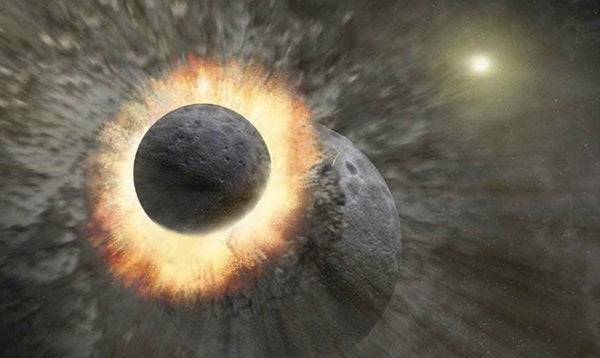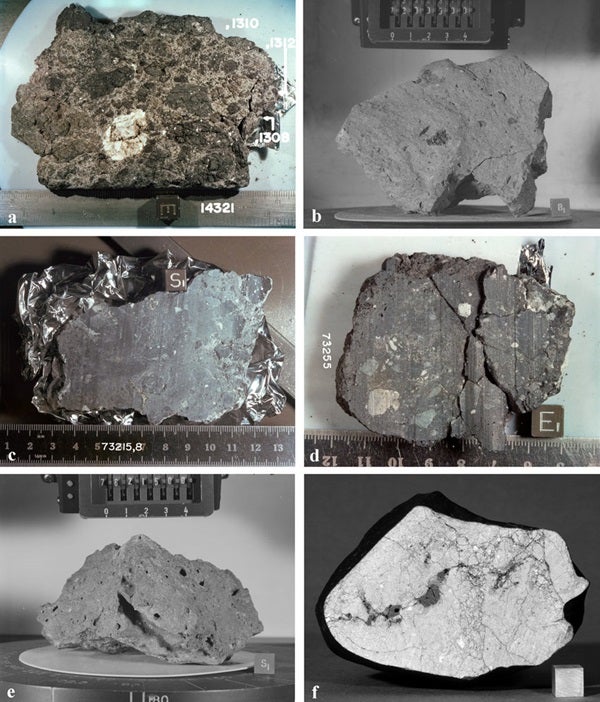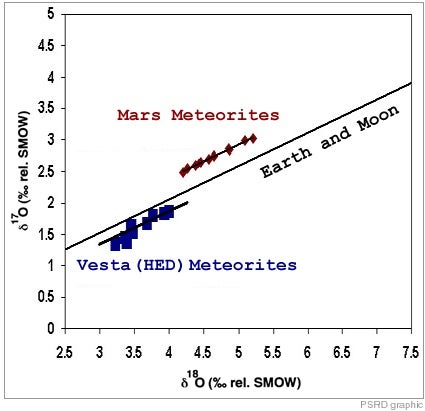The Moon has always beckoned. Long before our ancestors realized “wandering stars” were actually planets sharing the solar system with Earth, they recognized the Moon was a sort of sibling to our planet. And one of the first big questions to arise was surely: How did the Moon come to be?
Fifty years ago, humans accomplished one of the greatest feats of exploration when we set foot on the Moon. The importance of the Apollo program has been recognized as a political and technological triumph, but less widely appreciated is the scientific windfall brought by the nearly 900 pounds (400 kilograms) of lunar samples Apollo astronauts returned to Earth. These samples have ultimately proven vital to answering the age-old question of how the Moon formed.
Apollo rocks reveal the Moon’s past
Our planet has largely erased the record of its ancient past thanks to a continual re-shaping of its surface through geological activity. But the Moon is essentially dormant, so its heavily cratered surface preserves a record of solar system events going back billions of years. Thus, the Moon is a window into our planet’s primordial history.
A primary goal of the Apollo program was to distinguish among the then-leading theories for how the Moon formed: capture, co-formation, and fission. The capture theory posited the Moon formed independently from Earth, only to be captured by our planet later during a fortuitous close fly-by. The co-formation theory, however, envisioned the Moon grew alongside the Earth, with the pair accumulating mass from the same source of material. A third model, fission, proposed Earth rotated so rapidly that it became unstable, developing a bloated mid-section that shed material from its equator that would eventually become the Moon.
With the help of Apollo’s cache of lunar samples and data, researchers were introduced to tantalizing new clues and constraints for these three models. For instance, measuring the age of the oldest Apollo samples showed that the Moon must have formed some 4.5 billion years ago, only 60 million years or so after the first grains in our solar system condensed. This means the Moon came to be during the same early epoch that saw the birth of the planets.
From remote measurements of the Moon’s mass and radius, researchers also know its density is anomalously low, indicating it lacks iron. While about 30 percent of Earth’s mass is trapped in its iron-rich core, the core of the Moon only accounts for a few percent of its total mass. Despite this substantial difference in iron, Apollo samples later revealed that mantle rocks from the Moon and Earth have remarkably similar concentrations of oxygen. And because these lunar and terrestrial rocks are significantly different than meteorites coming from Mars or the asteroid belt, it shows the Moon and Earth’s mantle share a past connection. Additionally, compared with Earth, lunar rocks were also discovered to be more depleted in so-called volatile elements — those that vaporize easily upon heating — a hint that the Moon formed at high-temperatures.
Finally, researchers know that tidal interactions forced the Moon to spiral outward over time, which in turn caused Earth to spin more slowly. This implies the Moon first formed much closer to Earth than it is now. Precise measurements of the Moon’s position using surface reflectors placed during the Apollo program subsequently confirmed this, verifying the Moon’s orbit expands by about an inch each year.
Giant Impact Hypothesis
As is not uncommon in science, the new Apollo data, which was originally intended to test existing theories, instead inspired a new one. In the mid 1970s, researchers proposed the Giant Impact Hypothesis. The new impact scenario envisioned that at the end of its formation, Earth collided with another planet-sized body. This produced a great deal of debris in Earth’s orbit, which in turn coalesced into the Moon. The impacting planet would later be named “Theia,” after the Greek goddess who was the mother of the Moon.
The new theory seemed to reconcile multiple lines of evidence. If the material that formed the Moon originated from the outer layers of Earth and Theia, rather than from their cores, an iron-poor Moon would naturally result. A giant impact that struck Earth obliquely could also account for Earth’s rapid initial spin. Finally, the enormous impact energy associated with such an event would vaporize a substantial portion of the ejecta, accounting for the Moon’s lack of volatile materials.
Reaction to a violent lunar origin story
The scientific community was initially skeptical of this new model. The impact hypothesis was critiqued as being a contrived, ‘ad hoc’ solution that might represent an extremely unlikely event.
But at the same time, work on other competing models proved increasingly unsatisfying. The energy dissipation needed to capture an intact Moon during a close fly-by seemed implausible, if not impossible. Models of the Moon’s co-formation alongside Earth struggled to explain why the Moon would have obtained a vastly different proportion of iron. Additionally, the current angular momentum of the Earth-Moon system was too low to be explained by a rotationally unstable Earth that flung off enough material to form the Moon. Although, at first, researchers carried out little quantitative work on the giant impact model, it eventually emerged as the most promising idea during a mid-1980s conference on lunar origin, largely due to the weaknesses of competing theories.
But could a giant impact really produce the Moon? The answer to this question was not obvious. From basic physics, scientists know that ejecta launched from a spherical planet either entirely escape or fall back to the planet’s surface. It does enter into a stable orbit around the planet. However, a large enough impact — one by a body about the size of the planet itself — distorts the shape of the planet, altering its gravitational interactions with the ejecta.
Additionally, partially vaporized material can be accelerated as gases escape, modifying the material’s trajectory. However, assessing the impact of such effects required a new generation of computer simulations at a scale never before modeled. With then-available technology, such simulations were extremely challenging for computers, but researchers were able to demonstrate that giant impacts could produce orbiting ejecta that might assemble itself into the Moon.
But thanks to vast computational improvements, by the early 2000s, researchers identified what would later become known as the “canonical” impact theory: a low-velocity collision at about a 45-degree angle by Theia, which had a mass similar to that of Mars. Such an impact produces an iron-depleted disk of material massive enough to form the Moon and leads to a five-hour day on Earth. But over billions of years, tidal interactions then transfer angular momentum to the Moon, which drags the Moon outward while simultaneously slowing down the spin of Earth. This fits well with both Earth’s current 24-hour day, as well as the present orbital distance of the Moon.
Lingering questions
If the Moon were like other astronomical bodies, for which we typically only have remote observations, at this point, we would have likely declared the origin story of the Moon solved. In this case, however, we have physical samples from both the Moon and the Earth that we can compare. Explaining the chemical relationship of those samples has proved to be the biggest challenge to the Giant Impact Hypothesis, inspiring a flurry of work over the past decade on how exactly the Moon came to be.
The conundrum is this: In most giant, disk-forming impacts like those described above, it’s primarily material from the outer portions of Theia that are slingshot into Earth orbit. But we cannot know with certainty what Theia’s composition was when it impacted the Earth. If Theia, like Mars or main-belt asteroids, were made of different material than Earth, then a pre-lunar disk coming from Theia would lead to a Moon with a different composition than our planet.
Instead, data derived from Apollo lunar samples increasingly show that the Earth and Moon are almost chemically indistinguishable, not just for oxygen, but for many other elements too. Solving this “isotopic crisis” requires explaining how the collision of two independently formed planets, each with their own distinct history and composition, could have produced two such indistinguishable offspring.
One potential and feasible explanation is that Theia did have an Earth-like composition, perhaps due to both bodies forming at a similar distance from the Sun from shared material. In fact, there is evidence that the impactors that delivered the final 40 percent of Earth’s mass were quite Earth-like. However, new analyses of lunar samples highlight one elemental similarity between Earth and the Moon that doesn’t exactly add up, and it involves the element tungsten.
Tungsten is a particularly useful for understanding planet origin for two reasons: it tends to be incorporated into a planet’s metallic core as it forms, and one flavor (or isotope) of tungsten is produced by the radioactive decay of the element hafnium, which was prevalent only during the first roughly 60 million years of solar system history.
Unlike tungsten, hafnium does not tend to be incorporated into a planet’s core, and instead remains within its mantle. Thus, if a planet’s core formed during the first 60 million years — as was likely true for both Theia and early Earth — the abundance of a particular flavor of tungsten in its mantle would have been extremely sensitive to the timing of its core’s formation. In other words, even if Theia had been Earth-like in elements like oxygen by virtue of forming near Earth, an additional coincidence would be needed to produce the needed Earth-Moon tungsten match. Current estimates suggest such a coincidence would have been highly improbable.
An alternative concept envisions that the giant impact produced a disk that was at first chemically distinct from the Earth, but eventually vaporized portions of the Earth mixed together with vapor in the disk, equalizing their compositions. In this “equilibration” model, the mixing of material essentially erased the chemical signature of Theia in the Moon-forming disk.
Equilibration is an appealing process because it could account for why Earth and the Moon show similarities across many elements, including tungsten. However, such mixing must occur rapidly, because it likely only took the Moon a few hundred years to form in the disk. Whether such efficient mixing occurred over such a short time period remains uncertain.
Variations of the Giant Impact Hypothesis
In 2012, researchers made an important discovery by showing that certain special gravitational interactions with the Sun could have allowed Earth to slow its rotation by a factor of two or more by siphoning angular momentum from Earth’s spin to its orbit around the Sun. And if this is possible, it means the Earth’s rotation rate just after the Moon formed could then have been even faster than previously assumed — spinning about once every 2 hours instead of 5 hours — indicating an even more forceful impact with Theia.
Researchers have proposed a variety of “high-angular momentum” impacts that could produce such rapidly rotating Earths, including some that lead to a disk and planet with nearly equal mixtures of material from both Theia and early Earth. The exact slowdown needed to explain a larger, higher-energy impact, however, would require a narrow range of parameters that are, as yet, still quite uncertain, making the scenario’s overall likelihood unclear.
But what if the Moon were the product of multiple impacts, rather than just one? Recent alternative models consider the Moon formed via tens of smaller impacts with the Earth, rather than a single, giant impact. In this scenario, a relatively small impact creates a moonlet whose orbit spirals outward. A later impact produces another moonlet, whose orbital expansion could cause it to merge with the prior outer moonlet. A full-sized Moon built up by many smaller impactors with a range of compositions is more likely to end up with an Earth-like composition than a Moon produced by a single impact. However, the problem with this theory is that moonlets formed by different impacts don’t necessarily merge. Instead, it’s more likely that such moonlets would get ejected from orbit or eventually collide with Earth.
A final question is whether lunar impact simulations have considered all important aspects of a Moon-forming collision. Prior studies have generally found similar outcomes even when different computational approaches are adopted. However, a new paper proposes that if the Earth’s mantle was molten at the time of the giant impact — due to heating from a recent prior impact — it would have been more heated up more than previously predicted, leading to a more Earth-like disk, even for a giant impact scenario.
Where do we go from here?
Thus, we find lunar origin models at a crossroads of sorts. On one hand, many once-uncertain aspects of the Giant Impact Hypothesis have been validated. Current planet-formation models predict that giant impacts were commonplace in the inner solar system as Earth grew. Thousands of increasingly sophisticated simulations have established that many (if not most) of such giant impacts would produce disks and moons. The Moon’s bulk lack of iron, which is difficult to explain in competing models like intact capture, results naturally from a large impact. This is because the material that coalesced into the Moon comes from the outer mantles of the colliding bodies rather than from their iron-rich cores.
However, explaining other characteristics still poses a difficult challenge. Specifically, it’s hard to account for the ever-growing list of elemental similarities between the Earth and Moon, as revealed by lunar samples. One would expect the collision of two planets to have left some trace of their compositional differences, and yet — at least based on current data — such differences are not evident.
Researchers have proposed many new, creative explanations for how an impact (or impacts) could have produced a Moon so chemically similar to Earth. However, the new ideas impose additional constraints — for example that Theia must have had similar concentrations and flavors of both oxygen and tungsten, or that the angular momentum of the Earth-Moon system has drastically changed from its initial value. Thus, the impact theory still grapples with the question it faced nearly half a century ago: Would such an event have been likely, or does it require the Moon to be the product of a very unusual event?
Making headway depends on developments across several fronts. It’s not clear that existing models can account for all known traits of the Moon, including its volatile content and the tilt of its orbit relative to the plane of the solar system. Researchers will need to employ next-generation models to link the varied origin scenarios to predict the Moon’s properties, which will then be tested by comparing them to observations.
Fortunately, NASA and other countries are planning upcoming robotic and human Moon missions that hope to provide crucial new constraints. For example, new lunar samples may more fully reveal the Moon’s composition at depth, or improved measurements of lunar seismic activity and heat flow may better constrain the Moon’s internal composition and initial thermal state.
Ultimately, we will continue to pursue the answer for how our Moon came to be, not only so we can understand the history of our home world, but more generally, so we can unravel what our nearest cosmic neighbor can tell us about the formation and evolution of inner planets — both in our solar system and beyond.













